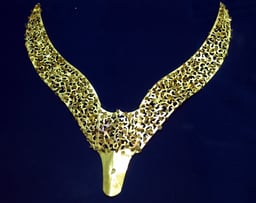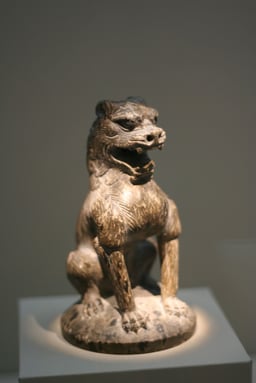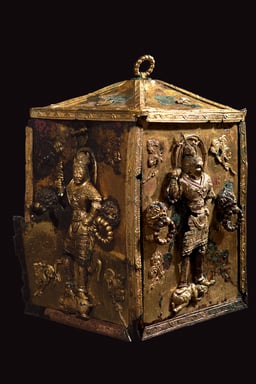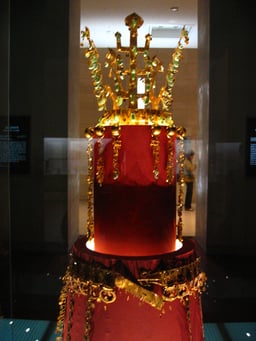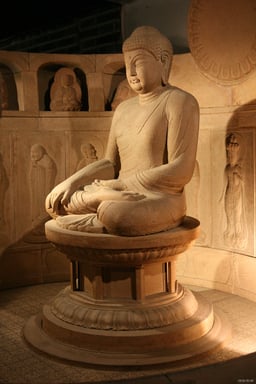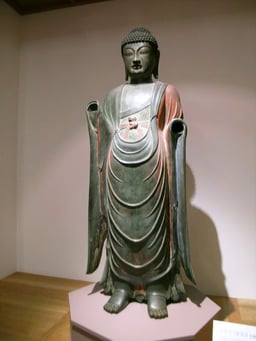Silla
565 VIEWS
Everipedia is now IQ.wiki - Join the IQ Brainlist and our Discord for early access to editing on the new platform and to participate in the beta testing.

Silla
References
[1]
Citation Linkopenlibrary.org57 BC according to the Samguk Sagi; however Seth 2010 notes that "these dates are dutifully given in many textbooks and published materials in Korea today, but their basis is in myth; only Goguryeo may be traced back to a time period that is anywhere near its legendary founding."
Sep 18, 2019, 7:49 PM
[3]
Citation Linkopenlibrary.org"...the first united Korean nation-state was established by the Silla Dynasty" The Two Koreas and the Great Powers, p. 48. Cambridge University Press.
Sep 18, 2019, 7:49 PM
[4]
Citation Linkwww.shilla.or.kr"Archived copy". Archived from the original on 2008-03-21. Retrieved 2008-03-08. Cite uses deprecated parameter |deadurl= (help)CS1 maint: archived copy as title (link) Retrieved on 2008-03-08
Sep 18, 2019, 7:49 PM
[5]
Citation Linken.wikisource.orgHistory of the Northern Dynasties Volume 94, History of Silla
Classical Chinese
新罗者,其先本辰韩种也。地在高丽东南,居汉时乐浪地。辰韩亦曰秦韩。相传言秦世亡人避役来适,马韩割其 东界居之,以秦人,故名之曰秦韩。其言语名物,有似中国人。....其文字、甲兵,同于中国。
English
Silla is a descendant of the Jinhan confederacy. Its land is in the southeast of Goguryeo and it is an old land, (once held by) the Lelang Commandery of Han dynasty. It is called Jinhan or Qinhan. According to Xiangyun (相伝), its founders were fugitives who arrived to avoid hardship during the Qin dynasty. Mahan gave their eastern land to them and settled those Qin people there. Therefore, this is called Qinhan. Their language and name are similar to Chinese.
— 北史 卷94 列傳第82 四夷 Chinese Wikisource has original text related to this article: 北史/卷094#新羅
Sep 18, 2019, 7:49 PM
[6]
Citation Linken.wikisource.orgSamguk Sagi volume 1
Classical Chinese
前此 中國之人 苦秦亂東來者衆 多處馬韓東 與辰韓雜居 至是寖盛 故馬韓忌之 有責焉
English
The location of Jinhan is east of Mahan. Traditionally, they are fugitives who came to Korea of old, to avoid hardships of the Qin dynasty. And Mahan said they gave them their eastern land.
— 三國史記 新羅本紀 卷1 赫居世居西干 Chinese Wikisource has original text related to this article: 三國史記/新羅本紀/卷1/赫居世 居西干#38年 (紀元前 20年)
Sep 18, 2019, 7:49 PM
[7]
Citation Linken.wikisource.orgRi Zhi Lu Volume 29
Classical Chinese
辰韩亦曰秦韩,相传言秦世亡人避役来适,马韩割其东界居之。以秦人故,名之曰秦韩。其言语名物有似中国人。
English
The location of Jinhan is east of Mahan. They are fugitives who came to Korea to avoid the hardship of the Qin dynasty. Mahan said they gave their eastern land to them. They set up castle fences and their language is similar to the one in Qin dynasty. It is also called Qinhan.
— 日知錄 卷29 Chinese Wikisource has original text related to this article: 日知錄/卷29
Sep 18, 2019, 7:49 PM
[8]
Citation Linkopenlibrary.orgHoresh, N. (2014). Asian Thought on China's Changing International Relations. Palgrave Macmillan. p. 175. ISBN 978-1137299321. "According to the Samguksagi entry for the 38th year of King Bak Hyeogeose of Silla, it is claimed that refugees from Qin settled in Jinhan, that is south-eastern Korea."
Sep 18, 2019, 7:49 PM
[9]
Citation Linken.wikisource.orgSamgungnyusa volume 1
Classical Chinese
後漢書云。辰韓耆老自言。秦之亡人來適韓國。而馬韓割東界地以與之。相呼為徒。有似秦語。故或名之為秦韓。
English
The History of the Later Han Dynasty writes, "An old person from Chenhan State said that some refugees came to Korea from the Chinese Empire of Qin, and Mahan gave them some land of her eastern border.
— 三國遺事 卷1 Chinese Wikisource has original text related to this article: Page:三國遺事 卷第一 1512年 奎章閣本.pdf/50
Sep 18, 2019, 7:49 PM
[10]
Citation Linken.wikisource.orgRecord of the Three Kingdoms Book of Wei, Volume 30, History of Jinhan
Classical Chinese
辰韓在馬韓之東,其耆老傳世,自言古之亡人避秦役來適韓國,馬韓割其東界地與之。有城柵。其言語不與馬韓同,名國為邦,弓為弧,賊為寇,行酒為行觴。
English
Jinhan confederacy is located in the east of Mahan confederacy. In the traditions of that area, the people of Jinhan were ancient fugitives who came to Korea to avoid the hardships of the Qin dynasty, and Mahan gave them their eastern land. They set up a castle fence and the language they speak is not the same as Mahan’s. There, they call “Guo” (Hanja: 国) (country) “Bang” (Hanja: 邦); “Gong” (Hanja: 弓) (arrow) “Hu” (Hanja: 弧); “Zei” (Hanja: 賊) (thief) “Kou” (Hanja: 寇); and “Xingjiu” (Hanja: 行酒) “Xingshang” (Hanja: 行觴).
— 三國志 魏書卷30辰韓伝 Chinese Wikisource has original text related to this article: 三國志/卷30#韓
Sep 18, 2019, 7:49 PM
[11]
Citation Linken.wikisource.orgBook of the Later Han Volume 85, History of Jinhan
Classical Chinese
耆老自言秦之亡人,避苦役,適韓國,馬韓割東界地與之。其名國為邦,弓为弧,賊為寇,行酒為行觴,相呼為徒,有似秦語,故或名之為秦韓。
English
The people of Jinhan are ancient fugitives who came to Korea to avoid the hardships of the Qin dynasty. Mahan said they gave their eastern land to them. In Jinhan, country is called “Bang (邦)”, arrow is called “Hu (弧)”, thief is called “Kou (寇)”, ”Xingjiu (行酒)” called as “Xingshang (行觴)” (turning cups of alcoholic drink) and they call each other “Tu (徒)”. Their language is similar to the language of Qin. So, this place is also called Qinhan.
— 後漢書 卷85辰韓伝 Chinese Wikisource has original text related to this article: 後漢書/卷85
Sep 18, 2019, 7:49 PM
[12]
Citation Linken.wikisource.orgBook of Jin Volume 97, History of Jinhan
Classical Chinese
辰韓在馬韓之東,自言秦之亡人避役入韓,韓割東界以居之,立城柵,言語有類秦人,由是或謂之爲秦韓。
English
The location of Jinhan is east of Mahan. They are fugitives who came to Korea to avoid the hardships of the Qin dynasty. Mahan said they gave their eastern land to them. They set up castle fences and their language is similar to the one in Qin dynasty. It is also called Qinhan.
— 晋書 巻97辰韓伝 Chinese Wikisource has original text related to this article: 晉書/卷097#馬韓 辰韓 弁韓
Sep 18, 2019, 7:49 PM
[13]
Citation Linkmonthly.chosun.comCho Gab-je. 騎馬흉노국가 新羅 연구 趙甲濟(月刊朝鮮 편집장)의 심층취재 내 몸속을 흐르는 흉노의 피 (in Korean). Monthly Chosun. Retrieved 2016-09-25.
Sep 18, 2019, 7:49 PM
[14]
Citation Linkwww.pressian.com김운회 (2005-08-30). 김운회의 '대쥬신을 찾아서' <23> 금관의 나라, 신라” (in Korean). 프레시안. Retrieved 2016-09-25.
Sep 18, 2019, 7:49 PM
[15]
Citation Linknews.chosun.com경주 사천왕사(寺) 사천왕상(四天王像) 왜 4개가 아니라 3개일까 (in Korean). 조선일보. 2009-02-27. Archived from the original on 2014-12-30. Retrieved 2016-09-25.
Sep 18, 2019, 7:49 PM
[16]
Citation Linkopenlibrary.org김창호, 〈문무왕릉비에 보이는 신라인의 조상인식 - 태조성한의 첨보 -〉, 《한국사연구》, 한국사연구회, 1986년
Sep 18, 2019, 7:49 PM
[17]
Citation Linkwww.nl.go.kr"자료검색>상세_기사 | 국립중앙도서관". www.nl.go.kr. Retrieved 2019-04-15.
Sep 18, 2019, 7:49 PM
[19]
Citation Linkwww.donga.com김대성. <이색보고> 金家 뿌리 탐사, 흉노왕의 후손 김일제 유적을 찾아서. 신동아. Retrieved 2016-09-25.
Sep 18, 2019, 7:49 PM
